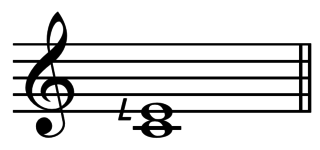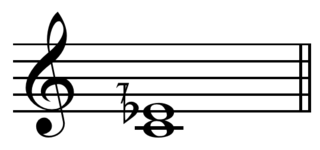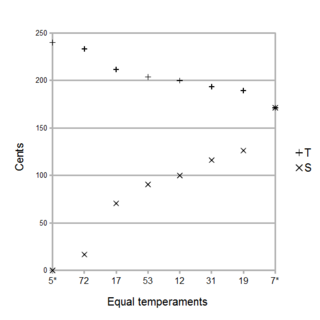Chords of septimal meantone
Septimal meantone of course has major and minor triads, and also diminished triads, which come in both an otonal, 5:6:7 form, as for instance C–E♭–F♯, and an inverted utonal form, as for instance C–D♯–F♯. As previously remarked, it has a septimal diminished seventh chord, which in various inversions can be C–E♭–G♭–B  , C–E♭–G♭–A, C–E♭–F♯–A or C–D♯–F♯–A. It also has a septimal augmented triad, which in various inversions can be C–E–G♯, C–E–A♭ or C–F♭–A♭. It has both a dominant seventh chord, C–E–G–B♭, and an otonal tetrad, C–E–G–A♯; the latter is familiar in common practice harmony under the name German sixth. It likewise has utonal tetrads, C–E♭–G–B
, C–E♭–G♭–A, C–E♭–F♯–A or C–D♯–F♯–A. It also has a septimal augmented triad, which in various inversions can be C–E–G♯, C–E–A♭ or C–F♭–A♭. It has both a dominant seventh chord, C–E–G–B♭, and an otonal tetrad, C–E–G–A♯; the latter is familiar in common practice harmony under the name German sixth. It likewise has utonal tetrads, C–E♭–G–B  , which in the arrangement B
, which in the arrangement B  –E♭–G–C becomes Wagner's Tristan chord. It has also the subminor triad, C–D♯–G, which is otonal, and the supermajor triad, C–F♭–G, which is utonal. These can be extended to subminor tetrads, C–D♯–G–A and supermajor tetrads C–F♭–G–B♭.
–E♭–G–C becomes Wagner's Tristan chord. It has also the subminor triad, C–D♯–G, which is otonal, and the supermajor triad, C–F♭–G, which is utonal. These can be extended to subminor tetrads, C–D♯–G–A and supermajor tetrads C–F♭–G–B♭.

Meantone temperament is a musical temperament, that is a tuning system, obtained by slightly compromising the fifths in order to improve the thirds. Meantone temperaments are constructed the same way as Pythagorean tuning, as a stack of equal fifths, but in meantone each fifth is narrow compared to the perfect fifth of ratio 3:2.
In music theory, an interval is a difference in pitch between two sounds. An interval may be described as horizontal, linear, or melodic if it refers to successively sounding tones, such as two adjacent pitches in a melody, and vertical or harmonic if it pertains to simultaneously sounding tones, such as in a chord.
In music theory, the tritone is defined as a musical interval composed of three adjacent whole tones. For instance, the interval from F up to the B above it is a tritone as it can be decomposed into the three adjacent whole tones F–G, G–A, and A–B. According to this definition, within a diatonic scale there is only one tritone for each octave. For instance, the above-mentioned interval F–B is the only tritone formed from the notes of the C major scale. A tritone is also commonly defined as an interval spanning six semitones. According to this definition, a diatonic scale contains two tritones for each octave. For instance, the above-mentioned C major scale contains the tritones F–B and B–F. In twelve-equal temperament, the tritone divides the octave exactly in half as 6 of 12 semitones or 600 of 1200 cents.

In music theory, the wolf fifth is a particularly dissonant musical interval spanning seven semitones. Strictly, the term refers to an interval produced by a specific tuning system, widely used in the sixteenth and seventeenth centuries: the quarter-comma meantone temperament. More broadly, it is also used to refer to similar intervals produced by other tuning systems, including most meantone temperaments.

In music theory a minor third is a musical interval that encompasses three half steps, or semitones. Staff notation represents the minor third as encompassing three staff positions. The minor third is one of two commonly occurring thirds. It is called minor because it is the smaller of the two: the major third spans an additional semitone. For example, the interval from A to C is a minor third, as the note C lies three semitones above A. Coincidentally, there are three staff positions from A to C. Diminished and augmented thirds span the same number of staff positions, but consist of a different number of semitones. The minor third is a skip melodically.

In music theory, a minor chord is a chord that has a root, a minor third, and a perfect fifth. When a chord has these three notes alone, it is called a minor triad. For example, the minor triad built on C, called a C minor triad, has pitches C–E♭–G:
A schismatic temperament is a musical tuning system that results from tempering the schisma of 32805:32768 to a unison. It is also called the schismic temperament, Helmholtz temperament, or quasi-Pythagorean temperament.

In music theory, a comma is a very small interval, the difference resulting from tuning one note two different ways. The word comma used without qualification refers to the syntonic comma, which can be defined, for instance, as the difference between an F♯ tuned using the D-based Pythagorean tuning system, and another F♯ tuned using the D-based quarter-comma meantone tuning system. Intervals separated by the ratio 81:80 are considered the same note because the 12-note Western chromatic scale does not distinguish Pythagorean intervals from 5-limit intervals in its notation. Other intervals are considered commas because of the enharmonic equivalences of a tuning system. For example, in 53TET, B♭ and A♯ are both approximated by the same interval although they are a septimal kleisma apart.

Otonality and utonality are terms introduced by Harry Partch to describe chords whose pitch classes are the harmonics or subharmonics of a given fixed tone (identity), respectively. For example: 1/1, 2/1, 3/1,... or 1/1, 1/2, 1/3,....
An Otonality is that set of pitches generated by the numerical factors (...identities)...over a numerical constant in the denominator. Conversely, a Utonality is the inversion of an Otonality, a set of pitches with a numerical constant in the numerator over the numerical factors...in the denominator.
Quarter-comma meantone, or 1⁄4-comma meantone, was the most common meantone temperament in the sixteenth and seventeenth centuries, and was sometimes used later. In this system the perfect fifth is flattened by one quarter of a syntonic comma (81:80), with respect to its just intonation used in Pythagorean tuning ; the result is 3/2 × 1⁄4 = 4√5 ≈ 1.49535, or a fifth of 696.578 cents. This fifth is then iterated to generate the diatonic scale and other notes of the temperament. The purpose is to obtain justly intoned major thirds. It was described by Pietro Aron in his Toscanello de la Musica of 1523, by saying the major thirds should be tuned to be "sonorous and just, as united as possible." Later theorists Gioseffo Zarlino and Francisco de Salinas described the tuning with mathematical exactitude.

In music, 53 equal temperament, called 53 TET, 53 EDO, or 53 ET, is the tempered scale derived by dividing the octave into 53 equal steps. Play (help·info) Each step represents a frequency ratio of 21⁄53, or 22.6415 cents, an interval sometimes called the Holdrian comma.

In music, 31 equal temperament, 31-ET, which can also be abbreviated 31-TET or 31-EDO, also known as tricesimoprimal, is the tempered scale derived by dividing the octave into 31 equal-sized steps. Play (help·info) Each step represents a frequency ratio of 31√2, or 38.71 cents.
In music, the septimal semicomma, a seven-limit semicomma, is the ratio 126/125 and is equal to approximately 13.79 cents. It is also called the small septimal comma and the starling comma after its use in starling temperament.

In music, the ratio 225/224 is called the septimal kleisma (play (help·info)). It is a minute comma type interval of approximately 7.7 cents. Factoring it into primes gives 2−5 32 52 7−1, which can be rewritten 2−1 (5/4)2 (9/7). That says that it is the amount that two major thirds of 5/4 and a septimal major third, or supermajor third, of 9/7 exceeds the octave. If the septimal kleisma is tempered out, as it is for instance in miracle temperament, septimal meantone temperament, septimal magic temperament and in many equal temperaments, for example 12, 19, 22, 31, 41, 53, 72 or 84 equal, then an augmented triad consisting of two major thirds and a supermajor third making up an octave becomes possible. The existence of such a chord, which might be termed the septimal kleisma augmented triad, is a significant feature of a tuning system.
In music, 22 equal temperament, called 22-TET, 22-EDO, or 22-ET, is the tempered scale derived by dividing the octave into 22 equal steps. Play (help·info) Each step represents a frequency ratio of 22√2, or 54.55 cents.

In music, the septimal major thirdplay (help·info), also called the supermajor third and sometimes Bohlen–Pierce third is the musical interval exactly or approximately equal to a just 9:7 ratio of frequencies, or alternately 14:11. It is equal to 435 cents, sharper than a just major third (5:4) by the septimal quarter tone (36:35). In 24-TET the septimal major third is approximated by 9 quarter tones, or 450 cents. Both 24 and 19 equal temperament map the septimal major third and the septimal narrow fourth (21:16) to the same interval.

In music, the septimal minor thirdplay (help·info), also called the subminor third, is the musical interval exactly or approximately equal to a 7/6 ratio of frequencies. In terms of cents, it is 267 cents, a quartertone of size 36/35 flatter than a just minor third of 6/5. In 24-tone equal temperament five quarter tones approximate the septimal minor third at 250 cents. A septimal minor third is almost exactly two-ninths of an octave, and thus all divisions of the octave into multiples of nine have an almost perfect match to this interval. The septimal major sixth, 12/7, is the inverse of this interval.

A regular diatonic tuning is any musical scale consisting of "tones" (T) and "semitones" (S) arranged in any rotation of the sequence TTSTTTS which adds up to the octave with all the T's being the same size and all the S's the being the same size, with the 'S's being smaller than the 'T's. In such a tuning, then the notes are connected together in a chain of seven fifths, all the same size which makes it a Linear temperament with the tempered fifth as a generator.

A septimal tritone is a tritone that involves the factor seven. There are two that are inverses. The lesser septimal tritone is the musical interval with ratio 7:5. The greater septimal tritone, is an interval with ratio 10:7. They are also known as the sub-fifth and super-fourth, or subminor fifth and supermajor fourth, respectively.

Five-limit tuning, 5-limit tuning, or 5-prime-limit tuning (not to be confused with 5-odd-limit tuning), is any system for tuning a musical instrument that obtains the frequency of each note by multiplying the frequency of a given reference note (the base note) by products of integer powers of 2, 3, or 5 (prime numbers limited to 5 or lower), such as 2−3·31·51 = 15/8.
 ♭
♭![]() Play (help·info). Similarly, the tuning with pure 7:4 intervals has a fifth of size 696.88 cents
Play (help·info). Similarly, the tuning with pure 7:4 intervals has a fifth of size 696.88 cents ![]() Play (help·info). 31 equal temperament has a fifth of size 696.77 cents
Play (help·info). 31 equal temperament has a fifth of size 696.77 cents ![]() Play (help·info), which does excellently for both of them, having the harmonic seventh only 1.1 cent lower, and the major third 1.2 cent higher than pure (while the fifth is 5.2 cents lower than pure). However, the difference is so small that it is mainly academic.[ citation needed ]
Play (help·info), which does excellently for both of them, having the harmonic seventh only 1.1 cent lower, and the major third 1.2 cent higher than pure (while the fifth is 5.2 cents lower than pure). However, the difference is so small that it is mainly academic.[ citation needed ]












